Effect of Magnetized Brackish Water Drip Irrigation on Water and Salt Transport Characteristics of Sandy Soil in Southern Xinjiang, China
Abstract
:1. Introduction
2. Materials and Methods
2.1. Experimental Site
2.2. Experimental Design
2.3. Sampling and Field Measurements
2.3.1. Soil Water Content
2.3.2. Soil Salinity and Soil Desalination Rate
2.3.3. Soil Salt Base Ions
2.3.4. Soil Total Carbon and Nitrogen Contents
2.4. Statistics and Analysis
3. Results
3.1. Soil Volumetric Water Content
3.2. Cumulative Change in Soil Water Storage before and after Drip Irrigation with Magnetized Water
3.3. Soil Salinity
3.4. Effect of Magnetized Brackish Water Irrigation on the Salt Balance of Jujube before and after Its Growth Period
3.5. Soil Salt Base Ions
3.6. Soil Total Carbon and Nitrogen Contents
4. Discussion
5. Conclusions
Author Contributions
Funding
Institutional Review Board Statement
Informed Consent Statement
Data Availability Statement
Conflicts of Interest
References
- Zhou, B.B.; Liang, C.F.; Chen, X.P.; Ye, S.T.; Peng, Y.; Yang, L.; Duan, M.L.; Wang, X.P. Magnetically-treated brackish water affects soil water-salt distribution and the growth of cotton with film mulch drip irrigation in Xinjiang, China. Agric. Water Manag. 2022, 263, 107487. [Google Scholar] [CrossRef]
- Wang, Z.H.; Wu, Q.; Fan, B.H.; Zhang, J.Z.; Li, W.H.; Zheng, X.R.; Li, H.; Guo, L. Testing biodegradable films as alternatives to plastic films in enhancing cotton (Gossypium hirsutum L.) yield under mulched drip irrigation. Soil Till Res. 2019, 192, 196–205. [Google Scholar] [CrossRef]
- Zhang, R.X.; Chu, G.X.; Wang, W.B.; Ye, J. Effects of magnetized water on salt leaching under drip irrigation condition. Xinjiang Agric. Sci. 2013, 50, 1656–1661. [Google Scholar]
- Wang, Q.J.; Xie, J.B.; Zhang, J.H.; Wei, K.; Sun, Y.; Li, Z.Y. Effects of magnetic field strength on magnetized water infiltration and soil water and salt movement. Trans. Chin. Soc. Agric. Mach. 2020, 51, 292–298. [Google Scholar]
- Ali, Y.; Rashidi, S.; Fatemeh, K. Applications of Magnetic Water Technology in Farming and Agriculture Development: A Review of Recent Advances. Curr. World Environ. 2014, 9, 695–703. [Google Scholar] [CrossRef]
- Zhou, S.; Zhang, R.X.; Chu, G.X.; Wang, W.B. Effects of magnetized water in agriculture. Agric. Eng. 2012, 2, 44–48. [Google Scholar]
- Pang, X.F.; Deng, B. The changes of macroscopic features and microscopic structures of water under influence of magnetic field. Phys. B 2008, 403, 3571–3577. [Google Scholar] [CrossRef]
- Sheng, T.M.; Zhang, S.J.; Xiao, B. Effect of magnetized water irrigation on soil water and salt distribution and spring corn yield. J. Soil Water Conserv. 2021, 35, 289–295. [Google Scholar]
- Ghauri, S.A.; Ansari, M.S. Increase of water viscosity under the influence of magnetic field. J. Appl. Phys. 2006, 100, 6459. [Google Scholar] [CrossRef]
- He, J.S.; Qi, F.Y.; Pei, L.W.; Yang, H.W.; Cai, R.; Ye, Z.Y. Integrated index assessing effect of magnetic treatment on liquid water’s associative structure. Trans. Chin. Soc. Agric. Eng. 2014, 30, 293–300. [Google Scholar]
- Wang, Q.J.; Zhang, J.H.; Men, Q.; Tan, S.; Zhou, L.W.; Liu, X.Y. Experiment on physical and chemical characteristics of activated brackish water by magnetization or ionization. Trans. Chin. Soc. Agric. Eng. 2016, 32, 60–66. [Google Scholar]
- Wang, L.; Guo, J.Y.; Liu, X.M.; Ma, F.Y.; Zhu, H.; Ma, X.S.; Wang, W.B. Effects of irrigation with magnetized salty water on biochemical properties of salty soil. J. Nucl. Agric. Sci. 2018, 32, 150–156. [Google Scholar]
- Liu, X.M.; Wang, L.; Wang, H.T.; Wang, Y.P.; Ma, F.Y.; Wan, X.; Zhu, H. Effects of magnetic brackish water irrigation on composition of soil exchangeable base ions. J. Soil Water Conserv. 2016, 30, 266–271. [Google Scholar]
- Behrouz, M.; Mojtaba, K.; Sayed-farhad, M. Effects of magnetized water on soil chemical components underneath trickle irrigation. J. Irrig. Drain. Eng. 2012, 138, 1075–1081. [Google Scholar]
- Bu, D.S.; Feng, W.G.; Cai, L.H.; Zhou, L. Effects of magnetization water on desalinization in cotton farmland of under-film dripping irrigation in Xin Jiang Province. Trans. Chin. Soc. Agric. Eng. 2010, 26, 163–166. [Google Scholar]
- Su, J.; Jiao, Y.; Yi, Y.L.; Zhang, D.G.; Cheng, X.L.; Liu, X.Y. Effects of magnetic field on catalase and peroxydase activities in brown earth. J. Shenyang Agric. Univ. 2007, 38, 70–74. [Google Scholar]
- Wang, L.; Guo, J.Y.; Liu, X.M.; Zhu, H.; Wang, H.T.; Wang, Y.; Wan, X.; Ma, F.Y.; Zhong, F.C. Effects of Magnetized Water Irrigation on Growth and Quality of Ziziphus jujuba ‘Dongzao’. Acta Hortic. Sin. 2016, 43, 653–662. [Google Scholar]
- Peng, Y.; Zhou, B.B.; Zhang, J.H.; Tang, X.W.; Zhou, Y.X.; Chen, X.P.; Wang, Q.J. Effects of mulched drip irrigation with magnetized water on soil water-salt distribution and growth characteristics of cotton. J. Soil Water Conserv. 2019, 33, 334–342. [Google Scholar]
- Zheng, D.M.; Jiang, Y.J.; Liu, W.Y.; Wang, J.Q.; Feng, W.G.; Wang, J.L. Effect of magnetization water on salt in cotton farmland after under-film dripping irrigation. Chin. J. Soil Sci. 2008, 39, 494–497. [Google Scholar]
- Li, W.H.; Wang, Z.H.; Zheng, D.M.; Zhang, J.Z. Effects of freezing and thawing on soil salinity in cotton fields by long-term drip irrigation of saline-alkaline soil in North Xinjiang. Agric. Res. Arid Areas 2015, 33, 40–46. [Google Scholar]
- Li, W.H.; Wang, Z.H.; Zheng, X.R.; Zhang, J.Z. Soil salinity variation characteristics of cotton field under long-term mulched drip irrigation. Trans. Chin. Soc. Agric. Eng. 2016, 32, 67–74. [Google Scholar]
- Li, W.H.; Wang, Z.H.; Zheng, X.R.; Zhang, J.Z. Variation of soil salinity in wasteland of oasis saline drip irrigation area in Xinjiang. J. Drain. Irrig. Mach. Eng. 2016, 32, 722–729. [Google Scholar]
- Yang, G.; Liu, S.H.; Yan, K. Effect of drip irrigation with brackish water on the soil chemical properties for a typical desert plant (Haloxylon ammodendron) in the manas river basin. Irrig. Drain. 2020, 69, 460–471. [Google Scholar] [CrossRef]
- Wang, Z.L.; Yang, G.; Wang, C.X.; Liu, S.H.; He, X.L.; Li, F.D.; Ren, F.T.; Long, A.H. Effects of saline water irrigation on cotton yield and soil physicochemical properties. J. Shihezi Univ. Nat. Sci. 2019, 37, 700–707. [Google Scholar]
- Liu, S.H.; Yang, G.; Zhang, Q.Y.; He, X.L.; Xue, L.Q.; Wang, Z.L.; Li, F.D.; Ren, F.T. Experimental study on water and solute movement in soil grown with desert plant haloxylon ammodendron under drip irrigation using saline water. J. Irrig. Drain. 2020, 39, 52–60. [Google Scholar]
- Zhou, B.B.; Yang, L.; Chen, X.P.; Ye, S.; Peng, Y.; Liang, C.F. Effect of magnetic water irrigation on the improvement of salinized soil and cotton growth in Xinjiang. Agric. Water Manag. 2021, 248, 106784. [Google Scholar] [CrossRef]
- Hachicha, M.; Kahlaoui, B.; Khamassi, N.; Misle, E.; Jouzdan, O. Effect of electromagnetic treatment of saline water on soil and crops. J. Saudi Soc. Agric. Sci. 2018, 17, 154–162. [Google Scholar] [CrossRef]
- Otsuka, I.; Ozeki, S. Does magnetic treatment of water change its properties? J. Phys. Chem. B 2006, 110, 1509–1512. [Google Scholar] [CrossRef]
- Cai, R.; Yang, H.W.; He, J.S. The effects of magnetic fields on water molecular hydrogen bonds. J. Mol. Struct. 2009, 938, 15–19. [Google Scholar] [CrossRef]
- Guo, B.; Han, H.B.; Chai, F. Influence of magnetic field on microstructural and dynamic properties of sodium, magnesium and calcium ions. Trans. Nonferrous Met. Soc. China 2011, 21, s494–s498. [Google Scholar] [CrossRef]
- Chang, K.T.; Weng, C. The effect of an external magnetic field on the structure of liquid water using molecular dynamics simulation. J. Appl. Phys. 2006, 100, 2923. [Google Scholar] [CrossRef] [Green Version]
- Yang, X.H. An analysis on magnetized mechanism of the magnetized water and it’s application in agriculture. J. Dezhou Univ. 2003, 6, 42–45. [Google Scholar]
- Ding, Z.R.; Zhao, Y.J.; Chen, F.L.; Chen, J.Z.; Duan, S.X. Magnetization mechanism of magnetized water. Acta Phys. Sin. 2011, 60, 432–439. [Google Scholar]
- Hilal, M.H.; EI-Fakhrani, Y.M.; Mabrouk, S.S.; Mohamed, A.I.; Ebead, B.M. Effect of Magnetic Treated Irrigation Water on Salt Removal from a Sandy Soil and on the Availability of certain Nutrients. Int. J. Eng. 2012, 2, 36–44. [Google Scholar]
- Zhang, R.X.; Wang, W.B.; Chu, G.X. Impacts of magnetized water irrigation on soil infiltration and soil salt leaching. Sci. Agric. Sin. 2014, 47, 1634–1641. [Google Scholar]
- Lin, R.R. Application of magnetic treatment in agriculture. J. Fujian Agric. For. Univ. Nat. Sci. Ed. 1999, 4, 509–512. [Google Scholar]
- Li, X.; Qiao, M.; Zhou, S.B. Effects of drip irrigation with magnetized water on soil desalinization in cotton field and cotton yield. Arid Zone Res. 2017, 34, 431–436. [Google Scholar]


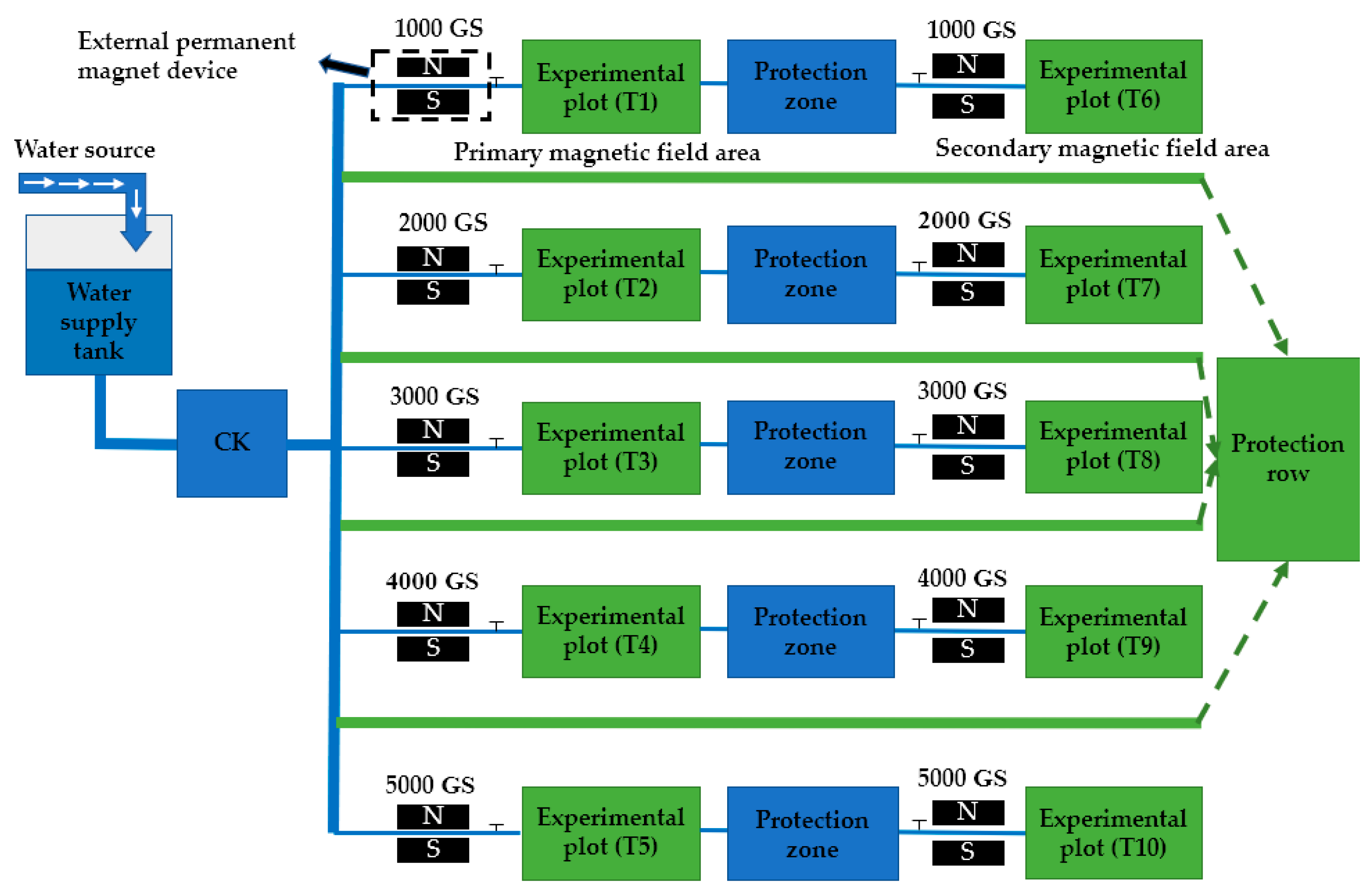
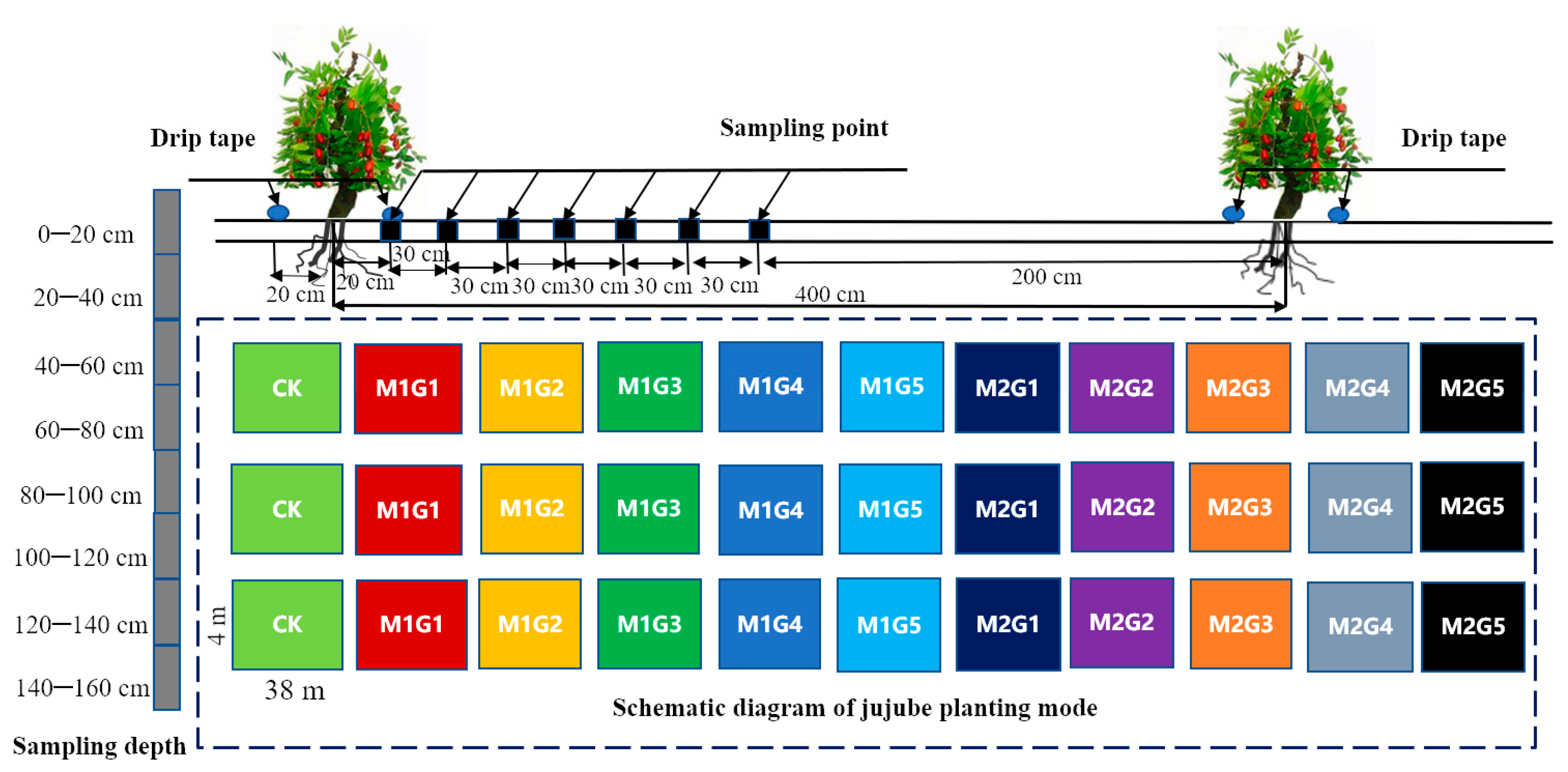

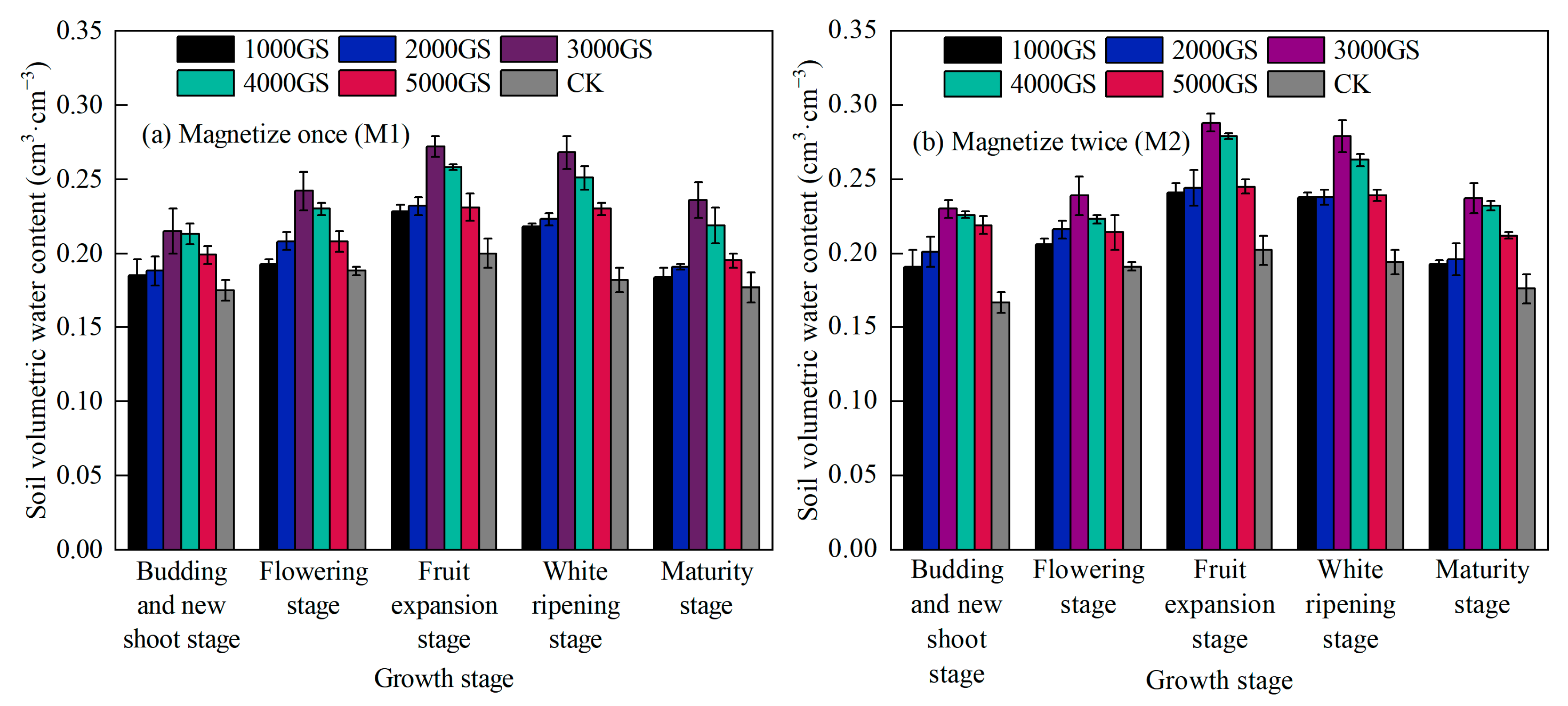
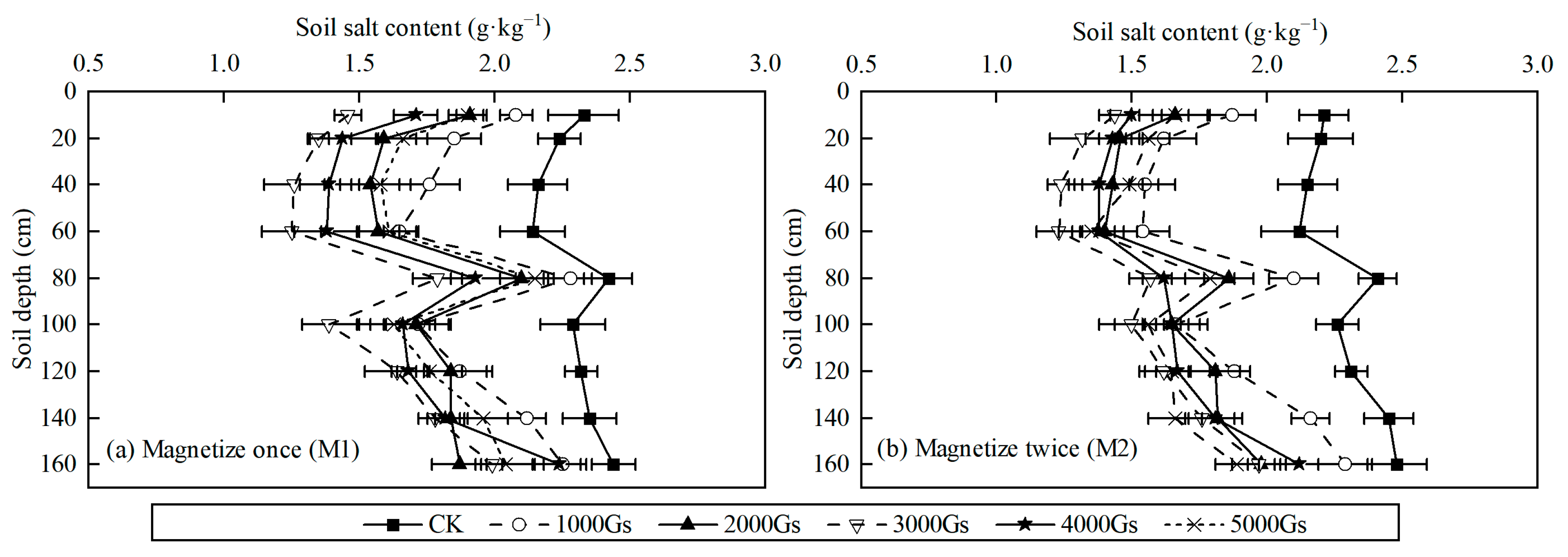
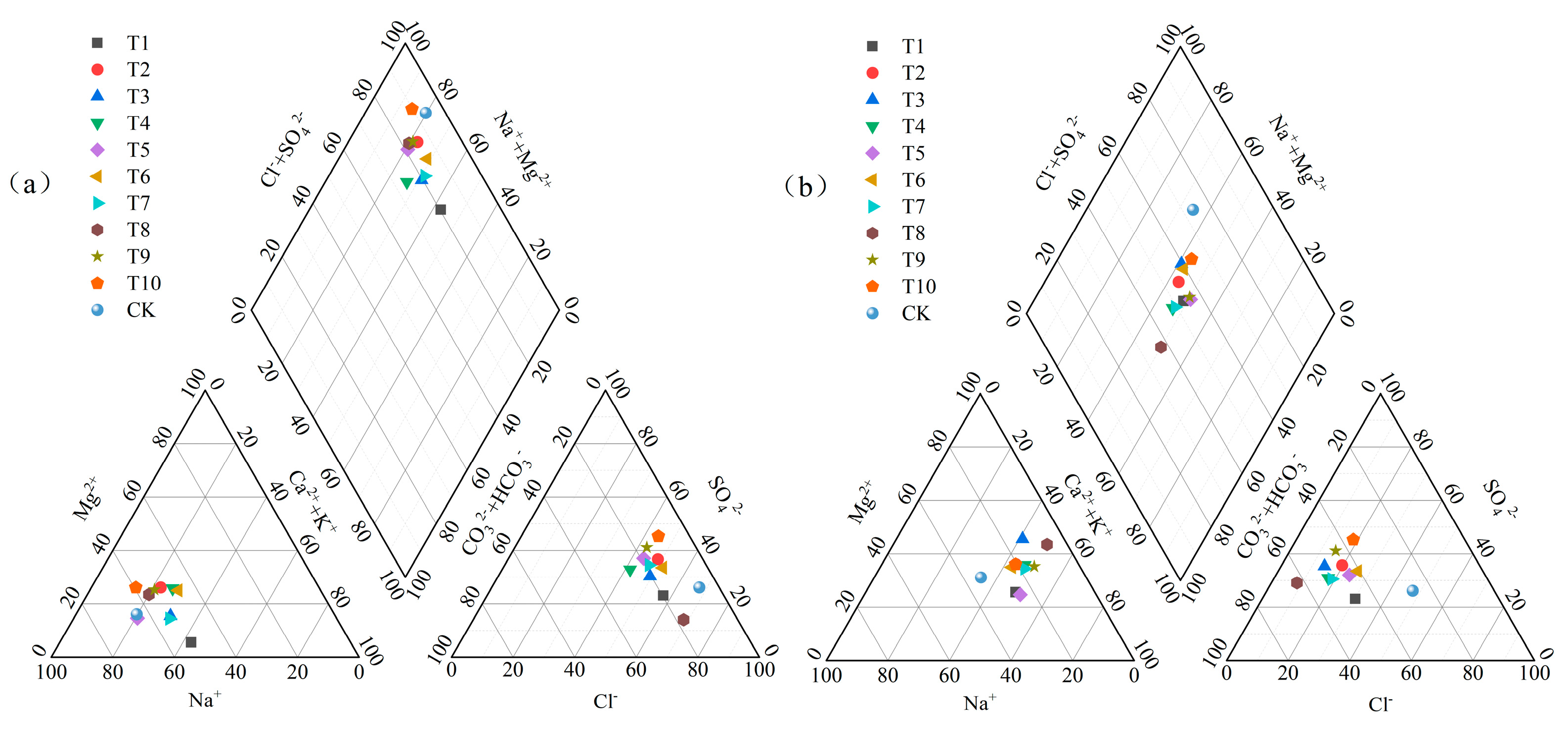
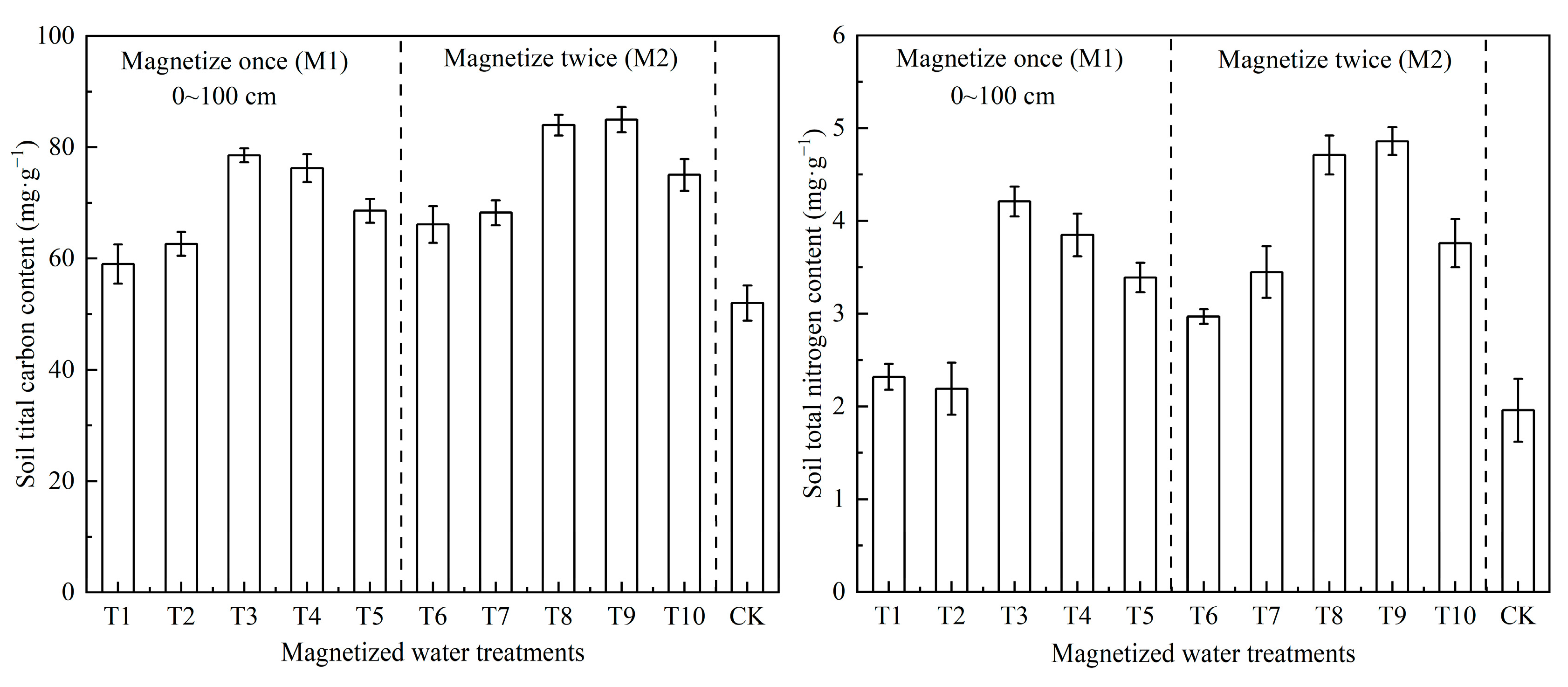
| Soil Depth (cm) | Soil Texture | Percentage of Sand (2–0.02 mm)/% | Percentage of Silt (0.02–0.002 mm)/% | Percentage of Clay (<0.002 mm)/% | Dry Bulk Density/(g·cm−3) | Field Water Holding Capacity/% | pH |
|---|---|---|---|---|---|---|---|
| 0–20 | Sand | 89.58 | 4.69 | 5.73 | 1.58 | 31.28 | 7.76 |
| 20–40 | Sand | 74.66 | 13.00 | 12.35 | 1.61 | 30.91 | 7.72 |
| 40–60 | Sand | 69.58 | 16.83 | 13.59 | 1.61 | 39.22 | 7.69 |
| 60–80 | Sand | 63.66 | 31.73 | 4.61 | 1.60 | 45.57 | 7.56 |
| 80–100 | Clay | 44.37 | 4.21 | 51.42 | 1.54 | 31.37 | 8.15 |
| 100–120 | Sand | 68.92 | 26.76 | 4.32 | 1.77 | 52.96 | 7.46 |
| 120–140 | Sand | 73.09 | 23.47 | 3.44 | 1.80 | 54.22 | 7.45 |
| Average value | / | 69.12 | 17.24 | 13.64 | 1.64 | 40.79 | 7.68 |
| Level Factor | Experimental Factors | Experimental Treatment | |
|---|---|---|---|
| Magnetization Frequency (M) | Magnetization Intensity (G/GS) | ||
| 0 | 0 | 0 | CK |
| 1 | 1 | 1000 | M1G1 (T1) |
| 2 | 2000 | M1G2 (T2) | |
| 3 | 3000 | M1G3 (T3) | |
| 4 | 4000 | M1G4 (T4) | |
| 5 | 5000 | M1G5 (T5) | |
| 1 | 2 | 1000 | M2G1 (T6) |
| 2 | 2000 | M2G2 (T7) | |
| 3 | 3000 | M2G3 (T8) | |
| 4 | 4000 | M2G4 (T9) | |
| 5 | 5000 | M2G5 (T10) | |
| Growth Stage | Irrigation Date | Irrigation Quota (m3/ha) |
|---|---|---|
| Budding and new shoot stage | 25 April 2021 | 560 |
| 9 May 2021 | 560 | |
| Flowering stage | 23 May 2021 | 600 |
| 6 June 2021 | 600 | |
| 20 June 2021 | 600 | |
| Fruit expansion stage | 4 July 2021 | 650 |
| 18 July 2021 | 650 | |
| 1 August 2021 | 650 | |
| White ripening stage | 15 August 2021 | 630 |
| 29 August 2021 | 630 | |
| Maturity stage | 12 September 2021 | 620 |
| Treatment | Magnetization Frequency | Magnetization Intensity/Gs | Change of Average Soil Water Storage ΔC/(mm) | Ratio of 0–80 cm Soil Water Storage and 0–160 cm Soil Water Storage (ΔR) | ||
|---|---|---|---|---|---|---|
| 0–80 cm | 0–120 cm | 0–160 cm | ||||
| CK | 0 | 0 | 56.99 d | 66.26 d | 149.08 b | 38.22% |
| M1G1 (T1) | 1 | 1000 | 62.20 c | 74.56 c | 151.91 b | 40.95% |
| M1G2 (T2) | 2000 | 63.31 c | 76.95 c | 151.34 b | 41.83% | |
| M1G3 (T3) | 3000 | 79.35 b | 95.90 a | 154.71 b | 51.29% | |
| M1G4 (T4) | 4000 | 79.53 b | 97.38 a | 154.11 b | 51.61% | |
| M1G5 (T5) | 5000 | 64.33 c | 83.86 b | 152.08 b | 42.30% | |
| M2G1 (T6) | 2 | 1000 | 66.62 c | 79.74 c | 153.25 b | 43.47% |
| M2G2 (T7) | 2000 | 69.91 c | 81.58 b c | 154.08 b | 45.37% | |
| M2G3 (T8) | 3000 | 85.07 a | 100.62 a | 161.98 a | 52.52% | |
| M2G4 (T9) | 4000 | 86.51 a | 97.49 a | 161.39 a | 53.60% | |
| M2G5 (T10) | 5000 | 70.52 b | 88.69 b | 152.34 b | 46.29% | |
| Treatment | Magnetization Frequency (M) | Magnetization Intensity (Gs) | Average Initial Salt Storage of Soil before Irrigation (g) | Soil Salt Storage after Harvest (g) | Change in Salt Storage (ΔS g−1) | Desalination Rate (%) |
|---|---|---|---|---|---|---|
| M1G1 (T1) | 1 | 1000 | 4265.10 | 5222.10 | −957.00 | 22.44 |
| M1G2 (T2) | 2000 | 4836.21 | 5740.06 | −903.85 | 18.69 | |
| M1G3 (T3) | 3000 | 5411.99 | 5950.9 | −538.91 | 9.96 | |
| M1G4 (T4) | 4000 | 3887.56 | 4525.82 | −638.26 | 16.42 | |
| M1G5 (T5) | 5000 | 4521.32 | 5247.18 | −725.86 | 16.05 | |
| M2G1 (T6) | 2 | 1000 | 4864.26 | 5659.66 | −795.40 | 16.35 |
| M2G2 (T7) | 2000 | 4952.13 | 5426.31 | −474.18 | 9.58 | |
| M2G3 (T8) | 3000 | 4652.89 | 4882.97 | −230.08 | 4.96 | |
| M2G4 (T9) | 4000 | 5012.64 | 5427.26 | −414.62 | 8.27 | |
| M2G5 (T10) | 5000 | 3987.46 | 4489.31 | −501.85 | 12.59 | |
| CK | 0 | 0 | 4419.58 | 6159.4 | −1739.8 | 39.37 |
Disclaimer/Publisher’s Note: The statements, opinions and data contained in all publications are solely those of the individual author(s) and contributor(s) and not of MDPI and/or the editor(s). MDPI and/or the editor(s) disclaim responsibility for any injury to people or property resulting from any ideas, methods, instructions or products referred to in the content. |
© 2023 by the authors. Licensee MDPI, Basel, Switzerland. This article is an open access article distributed under the terms and conditions of the Creative Commons Attribution (CC BY) license (https://creativecommons.org/licenses/by/4.0/).
Share and Cite
Wang, D.; Zhang, L.; Zhang, J.; Li, W.; Li, H.; Liang, Y.; Han, Y.; Luo, P.; Wang, Z. Effect of Magnetized Brackish Water Drip Irrigation on Water and Salt Transport Characteristics of Sandy Soil in Southern Xinjiang, China. Water 2023, 15, 577. https://doi.org/10.3390/w15030577
Wang D, Zhang L, Zhang J, Li W, Li H, Liang Y, Han Y, Luo P, Wang Z. Effect of Magnetized Brackish Water Drip Irrigation on Water and Salt Transport Characteristics of Sandy Soil in Southern Xinjiang, China. Water. 2023; 15(3):577. https://doi.org/10.3390/w15030577
Chicago/Turabian StyleWang, Dongwang, Liang Zhang, Jinzhu Zhang, Wenhao Li, Haiqiang Li, Yonghui Liang, Yue Han, Pengcheng Luo, and Zhenhua Wang. 2023. "Effect of Magnetized Brackish Water Drip Irrigation on Water and Salt Transport Characteristics of Sandy Soil in Southern Xinjiang, China" Water 15, no. 3: 577. https://doi.org/10.3390/w15030577
APA StyleWang, D., Zhang, L., Zhang, J., Li, W., Li, H., Liang, Y., Han, Y., Luo, P., & Wang, Z. (2023). Effect of Magnetized Brackish Water Drip Irrigation on Water and Salt Transport Characteristics of Sandy Soil in Southern Xinjiang, China. Water, 15(3), 577. https://doi.org/10.3390/w15030577







